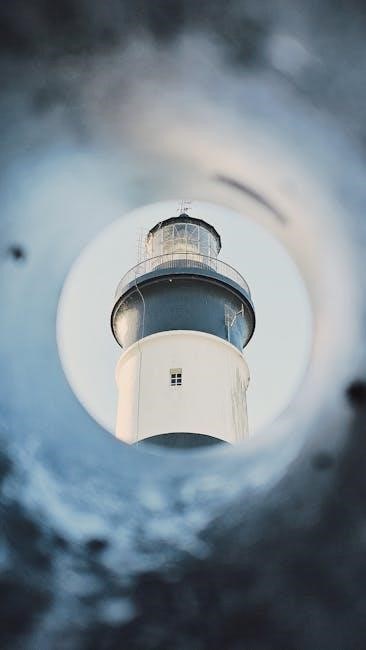Light guides are devices that direct and transmit light for various applications. Their historical evolution has made them crucial in modern technology, offering versatile solutions.
1.1 Definition and Purpose
Light guides are optical devices designed to direct and transmit light efficiently. They are typically made of transparent materials like glass or plastic, enabling light to travel through them with minimal loss. Their primary purpose is to control and distribute light for various applications, ensuring clarity and intensity over distances. This makes them essential for illumination, data transmission, and imaging technologies, where precise light management is critical.
1.2 Historical Background
Light guides have evolved significantly since their inception in the 19th century. The concept of light transmission through transparent media was first demonstrated by John Tyndall in the 1870s. Modern light guides, particularly fiber optics, were developed in the mid-20th century by pioneers like Harold Hopkins and Narinder Singh Kapany. These advancements revolutionized telecommunications and medical diagnostics, paving the way for today’s sophisticated applications.

Types of Light Guides
Light guides are categorized into flexible, rigid, and fiber optic types, each offering unique benefits. Flexible guides bend easily, while rigid ones maintain shape, and fiber optics excel in precision.
2.1 Flexible Light Guides
Flexible light guides are designed for applications requiring bendability without loss of light intensity. Made from specialized polymers, they maintain optical clarity and durability even when bent. Their versatility makes them ideal for medical devices, automotive interiors, and consumer electronics. These guides are lightweight and resistant to environmental factors, ensuring reliable performance in dynamic environments. Their adaptability and resilience contribute to their widespread use in modern technology.
2.2 Rigid Light Guides
Rigid light guides are durable, solid structures designed for stable light transmission. Unlike flexible guides, they maintain shape under stress, making them ideal for high-temperature and heavy-duty applications. Commonly used in automotive and aerospace industries, these guides ensure precise light delivery. Their rigid nature enhances optical clarity and minimizes signal loss. While less adaptable than flexible guides, their robust construction ensures long-term reliability in demanding environments, making them a preferred choice for industrial and high-performance lighting systems.
2.3 Fiber Optic Light Guides
Fiber optic light guides utilize thin glass or plastic fibers to transmit light through total internal reflection. These guides are highly efficient, offering precise light delivery with minimal loss. Commonly used in medical procedures and telecommunications, they excel in applications requiring high-speed data transmission. Their compact size and resistance to electromagnetic interference make them ideal for complex systems. Fiber optic guides are renowned for their clarity and durability, ensuring reliable performance in diverse environments.

Materials Used in Light Guides
Light guides are typically made from glass, plastic, or specialized polymers. Glass offers high clarity and durability, while plastics provide flexibility and cost-effectiveness. Polymers enable advanced optical properties.
3.1 Glass
Glass is a popular material for light guides due to its high refractive index and excellent optical clarity. It is highly durable and resistant to scratches, making it suitable for demanding environments. Glass light guides are ideal for applications requiring precise light transmission, such as medical devices or high-temperature settings. Additionally, glass can be doped with rare-earth elements to enhance its optical properties, enabling it to transmit specific wavelengths efficiently. Despite its rigidity, glass can be shaped into various forms like fibers or rods for diverse uses.
3.2 Plastic
Plastic light guides are lightweight, flexible, and cost-effective, making them ideal for consumer electronics and automotive applications. They offer excellent design flexibility, allowing complex shapes and easy integration into compact spaces. While plastics may lack the optical clarity of glass, they provide sufficient performance for many lighting solutions. Their durability and resistance to environmental factors make them a practical choice for everyday use, ensuring reliability in various industrial and commercial settings.
3.4 Specialized Polymers
Specialized polymers are advanced materials used in light guides, offering enhanced optical and mechanical properties. Polymers like PMMA (polymethyl methacrylate) and polycarbonate are favored for their high light transmittance and durability. These materials excel in demanding environments, resisting scratches and environmental stress. Their versatility allows for precise light control, making them ideal for fiber optics and LED systems. Additionally, specialized polymers can be engineered for specific wavelengths, ensuring optimal performance in diverse applications, from medical devices to aerospace systems. Their adaptability and reliability make them a cornerstone of modern light guide technology.

Manufacturing Process
The manufacturing process involves extrusion, drawing, and polishing to create high-quality light guides, ensuring precise optical properties and durability for various applications.

4.1 Extrusion
Extrusion is a key manufacturing process for light guides, involving the shaping of raw materials like glass or plastic under high temperatures. The material is heated and forced through a die to achieve the desired form. This method ensures precise control over the optical properties and dimensions of the light guide. Extrusion is widely used for its efficiency in producing consistent, high-quality components essential for various applications, from medical devices to consumer electronics.
4.2 Drawing
Drawing is a manufacturing process where raw materials are heated and formed into fibers or sheets. For light guides, glass or plastic is heated and pulled through dies to create thin, precise shapes. This method ensures high optical quality and uniform dimensions. Drawing is often used for fiber optic light guides, enabling the production of long, flexible, and durable components. The process is crucial for applications requiring high precision and consistent optical performance, making it a cornerstone in light guide manufacturing.
4.3 Polishing
Polishing is the final step in light guide production, ensuring smooth, scratch-free surfaces. This process involves using progressively finer abrasives to achieve high optical clarity. Polishing is critical for minimizing light scattering and maximizing efficiency. For glass and plastic light guides, specialized techniques are applied to maintain precise surface quality. Proper polishing ensures optimal light transmission and durability, making it essential for both functional and aesthetic performance in various applications.

Applications of Light Guides
Light guides are widely used in medical, automotive, consumer electronics, and aerospace industries. They provide efficient illumination solutions across diverse fields, enhancing performance and functionality.
5.1 Medical Applications
Light guides play a crucial role in medical diagnostics and treatments. They are used in endoscopy for internal examinations, surgical lighting for precise illumination, and dental procedures for targeted light delivery.
Their durability and efficiency make them ideal for sterile environments. Additionally, light guides enable minimally invasive procedures, reducing recovery times and improving patient outcomes.
In diagnostics, they assist in imaging techniques, while in therapeutics, they are used for phototherapy and laser treatments. Their versatility and reliability have made them indispensable in modern medicine.
5.2 Automotive Lighting
Light guides are integral to modern automotive lighting systems, enhancing visibility and safety. They are used in LED headlights, taillights, and interior lighting, ensuring even illumination.
Their durability and resistance to vibration make them ideal for vehicles. Light guides also enable sleek, energy-efficient designs, contributing to reduced power consumption.
In dashboard displays, they provide clear, consistent lighting for controls and indicators. Their versatility and reliability make them a cornerstone of automotive lighting technology.
5.3 Consumer Electronics
Light guides play a pivotal role in consumer electronics, enhancing display backlighting and illumination. They are widely used in smartphones, tablets, and televisions to ensure uniform light distribution.
In wearable devices like smartwatches, light guides enable efficient LED illumination, reducing power consumption. Their thin, lightweight designs make them ideal for modern gadgets.
Additionally, they are integrated into home appliances and gaming consoles, providing energy-efficient and visually appealing solutions. This versatility drives their popularity in the consumer electronics industry.
5.4 Aerospace
Light guides are integral to aerospace applications, providing efficient illumination for cabins, cockpits, and instrumentation; Their durability and resistance to extreme conditions make them ideal for aviation environments.
They enable energy-efficient lighting solutions, reducing power consumption and heat generation, which is critical in aircraft systems. Additionally, light guides enhance visibility in low-light conditions, improving safety for pilots and passengers. Their versatility and reliability contribute significantly to modern aerospace technologies.

Advantages of Light Guides
Light guides offer high efficiency, durability, and design flexibility, making them ideal for various applications. Their ability to transmit light with minimal loss enhances performance and longevity in diverse settings.
6.1 High Efficiency
Light guides are renowned for their high efficiency in transmitting light with minimal loss. Their advanced designs, including reflective surfaces and precision engineering, ensure optimal light distribution. This efficiency is crucial in applications like medical devices, where precise light delivery is vital. The use of high-quality materials, such as glass or specialized polymers, further enhances their ability to maintain light intensity over long distances. This makes them indispensable in fields requiring reliable and consistent illumination, ensuring superior performance in diverse operational settings.
6.2 Durability
Light guides are highly durable, withstanding environmental stressors like heat, moisture, and physical stress. Their robust construction, often using materials like glass or specialized polymers, ensures long-term reliability. This durability is critical in industrial and outdoor applications, where exposure to harsh conditions is common. The ability to maintain performance over time makes light guides a reliable choice for demanding environments, reducing the need for frequent replacements and ensuring consistent light transmission across various settings.
6.3 Design Flexibility
Light guides offer exceptional design flexibility, allowing customization to meet specific application needs. Their adaptable materials and manufacturing processes enable tailored shapes, sizes, and configurations. This flexibility is particularly valuable in complex systems, where precise light distribution is required. Whether bending around corners or fitting into tight spaces, light guides can be engineered to suit diverse design requirements, making them versatile components in modern technology and innovation.

Challenges and Limitations
Light guides face challenges like signal loss, material degradation, and high costs. These factors can limit their efficiency and lifespan in various applications.
7.1 Signal Loss
Signal loss in light guides occurs due to absorption, scattering, or bending, reducing light intensity. This degradation affects performance, especially in long or complex systems, requiring precise engineering to minimize.
7.2 Material Degradation
Material degradation in light guides occurs due to environmental factors, such as UV exposure, temperature fluctuations, or chemical interactions, leading to reduced transmission efficiency over time. This degradation can cause discoloration, brittleness, or surface damage, ultimately affecting the device’s performance. In medical or automotive applications, where reliability is critical, material degradation poses significant challenges, necessitating the use of high-durability materials to maintain optimal light transmission and system integrity.
7.4 Cost
The production and implementation of light guides can be costly due to the precision required in manufacturing and material selection. High-quality materials, such as specialized polymers or glass, increase expenses. Additionally, complex designs or miniaturization for advanced applications can drive up costs. While certain plastics offer affordability, they may lack durability for demanding environments. Balancing cost and performance is crucial, especially in industries like aerospace or medical, where reliability is paramount. Research and development investments further contribute to higher initial expenses.

Future Trends
Future trends in light guides include advances in materials, integration with smart technologies, and miniaturization. These innovations will enhance efficiency, customization, and application versatility across industries.
8.1 Advances in Materials
Advances in materials are revolutionizing light guides, with developments in high-refractive-index polymers and nanomaterials enhancing light transmission efficiency. These innovations enable thinner, more durable, and customizable light guides. Researchers are also exploring eco-friendly materials, reducing environmental impact while maintaining performance. Such advancements are pivotal for next-gen applications in medical devices, consumer electronics, and aerospace, where lightweight and high-performance solutions are critical. These material breakthroughs are driving the future of light guide technology, ensuring improved reliability and versatility across industries.
8.2 Integration with Smart Technologies
Light guides are increasingly being integrated with smart technologies, enabling advanced connectivity and automation. Sensors embedded in light guides can monitor and adjust lighting conditions in real-time, optimizing performance. IoT-enabled light guides allow seamless integration with smart systems, enabling voice control and remote adjustments. This integration enhances efficiency in applications like smart homes, medical devices, and automotive systems. By combining light guides with AI-driven technologies, users can achieve personalized lighting solutions that adapt to environmental changes, improving functionality and user experience across various industries.
8.3 Miniaturization
Miniaturization of light guides is a growing trend, driven by advancements in materials and manufacturing techniques. Smaller, more compact designs enable integration into wearable devices, medical instruments, and portable electronics. This reduction in size enhances portability and versatility, making light guides suitable for applications where space is limited. Improved manufacturing precision ensures that miniaturized light guides maintain high performance and efficiency, expanding their potential in emerging fields like micro-optics and consumer electronics.
